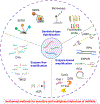Sample-to-answer salivary miRNA testing: New frontiers in point-of-care diagnostic technologies
- PMID: 38783564
- PMCID: PMC11141732
- DOI: 10.1002/wnan.1969
Sample-to-answer salivary miRNA testing: New frontiers in point-of-care diagnostic technologies
Abstract
MicroRNA (miRNA), crucial non-coding RNAs, have emerged as key biomarkers in molecular diagnostics, prognosis, and personalized medicine due to their significant role in gene expression regulation. Salivary miRNA, in particular, stands out for its non-invasive collection method and ease of accessibility, offering promising avenues for the development of point-of-care diagnostics for a spectrum of diseases, including cancer, neurodegenerative disorders, and infectious diseases. Such development promises rapid and precise diagnosis, enabling timely treatment. Despite significant advancements in salivary miRNA-based testing, challenges persist in the quantification, multiplexing, sensitivity, and specificity, particularly for miRNA at low concentrations in complex biological mixtures. This work delves into these challenges, focusing on the development and application of salivary miRNA tests for point-of-care use. We explore the biogenesis of salivary miRNA and analyze their quantitative expression and their disease relevance in cancer, infection, and neurodegenerative disorders. We also examined recent progress in miRNA extraction, amplification, and multiplexed detection methods. This study offers a comprehensive view of the development of salivary miRNA-based point-of-care testing (POCT). Its successful advancement could revolutionize the early detection, monitoring, and management of various conditions, enhancing healthcare outcomes. This article is categorized under: Diagnostic Tools > Biosensing Diagnostic Tools > Diagnostic Nanodevices.
Keywords: cancer; infectious disease; microRNA; multiplexed detection; neurodegenerative disease; point of care testing (POCT); saliva.
© 2024 The Author(s). WIREs Nanomedicine and Nanobiotechnology published by Wiley Periodicals LLC.
Conflict of interest statement
Conflict of interest statement
The authors declare no conflicts of interest.
Figures









Similar articles
-
Advances in Point-of-Care Testing of microRNAs Based on Portable Instruments and Visual Detection.Biosensors (Basel). 2023 Jul 20;13(7):747. doi: 10.3390/bios13070747. Biosensors (Basel). 2023. PMID: 37504145 Free PMC article. Review.
-
Salivary diagnostics: opportunities and challenges.Theranostics. 2024 Oct 21;14(18):6969-6990. doi: 10.7150/thno.100600. eCollection 2024. Theranostics. 2024. PMID: 39629130 Free PMC article. Review.
-
Electrochemical Biosensors for the Detection of Exosomal microRNA Biomarkers for Early Diagnosis of Neurodegenerative Diseases.Anal Chem. 2025 Mar 18;97(10):5355-5371. doi: 10.1021/acs.analchem.4c02619. Epub 2025 Mar 9. Anal Chem. 2025. PMID: 40057850 Free PMC article. Review.
-
Lab-on-a-Disc for Point-of-Care Infection Diagnostics.Acc Chem Res. 2021 Oct 5;54(19):3643-3655. doi: 10.1021/acs.accounts.1c00367. Epub 2021 Sep 13. Acc Chem Res. 2021. PMID: 34516092
-
Molecular engineering of functional DNA molecules toward point-of-care diagnostic devices.Chem Commun (Camb). 2025 Mar 11;61(22):4316-4338. doi: 10.1039/d5cc00338e. Chem Commun (Camb). 2025. PMID: 39998439 Review.
Cited by
-
CRISPR-based strategies for sample-to-answer monkeypox detection: current status and emerging opportunities.Nanotechnology. 2024 Nov 4;36(4):042001. doi: 10.1088/1361-6528/ad892b. Nanotechnology. 2024. PMID: 39433062 Free PMC article. Review.
-
Compact multiplex PCR device for HIV-1 and HIV-2 viral load determination from finger-prick whole blood in resource-limited settings.Biosens Bioelectron. 2025 Mar 1;271:116997. doi: 10.1016/j.bios.2024.116997. Epub 2024 Nov 26. Biosens Bioelectron. 2025. PMID: 39637742
-
An experimental study to estimate the early postmortem interval based on the degradation of lncRNAs in rat brain tissue.Sci Rep. 2024 Aug 23;14(1):19586. doi: 10.1038/s41598-024-70678-y. Sci Rep. 2024. PMID: 39179611 Free PMC article.
-
Efficient solid-phase extraction of oligo-DNA from complex media using a nitrocellulose membrane modified with carbon nanotubes and aminated reduced graphene oxide.Sci Rep. 2025 Feb 13;15(1):5325. doi: 10.1038/s41598-025-89705-7. Sci Rep. 2025. PMID: 39948136 Free PMC article.
-
Gastric Cancer and Microbiota: Exploring the Microbiome's Role in Carcinogenesis and Treatment Strategies.Life (Basel). 2025 Jun 23;15(7):999. doi: 10.3390/life15070999. Life (Basel). 2025. PMID: 40724502 Free PMC article. Review.
References
Publication types
MeSH terms
Substances
Grants and funding
LinkOut - more resources
Full Text Sources

